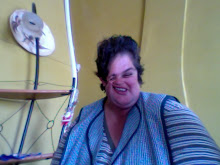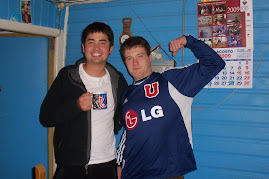
As I have said numerous times in the past, my time here has continued to be incredible but my final days here in Los Alamos are sneaking up on me. After this weekend I will only have 3 more weeks of classes with my students. Since I am here to teach, I find it only fitting that I fill you in on the education system here in Chile and that I tell you a little about the school that I teach at.
Liceo B-55
Since arriving here in Los Alamos, I have been teaching at a public high school named Liceo Politecnico Caupolican B-55 more commonly known as “Liceo B-55”. The school consists of just over 800 students from grades 9-12 and as far as Chilean high schools go, this is a normal sized high school. Each class consists of anywhere from 30-40 students and class periods last for 1.5 hours. Currently I work with one of the English teachers, but I teach my classes all by myself and I have complete autonomy with the material that I choose to teach. The system that we use is that I get half of the students for the first 45 minutes of the block, and then we switch and I get the second half of the students for the second 45 minutes. I have really enjoyed this system as it reduces class sizes, which allows me to have more 1 on 1 time with students, I can focus on students specific needs, and it helps to reduce behavior management issues.
One of the major differences between Chilean high schools and high schools in the United States is that teachers do not have their own classrooms, but rather the student have their own classrooms. Students are with the same group of students all day everyday in the same classroom. Because of this system, the teachers are unable to impact the environment of the classroom with posters or visual aids so the walls are all blank with an occasional piece of graffiti from the students. Also as a result of this system, the teachers’ lounge has become a safe haven for the teachers. I cant imagine what would happen if we told all the teachers in the United States that they were no longer going to have their own classrooms and that they had to change rooms every hour! Currently, Karyn (the other volunteer at the high school) and myself are the only two teachers with our own classroom. Thanks to our contract, this is a requirement set forth by the organization we work for.
Typical Students
One of the best parts of being here in Chile has been getting to know my students. I have had a blast spending time with them in class as well outside of class. The kids in the high school are just like high school kids in the United States. They enjoy spending time with their friends, listening to music, texting, playing sports, watching movies, goofing around, etc. Actually now that I think about it, I would say that the students enjoy listening to music and texting way too much. I am not positive, but I don’t think teachers do much about cell phones in class because students are always pulling out their phones in class and trying to listen to their headphones. I have cracked down on this but I think it took some getting used to for the students.
As far as extra-curricular activities go, Chile has a much different system than the United States. Instead of having sports teams, or music/theater departments, they have what are called “tallers”. These are times set aside during the week in which students can participate in activities such as ping pong, chess, karate, soccer, basketball, etc. These are incredibly informal and if students want to show up they can, but if they don’t want to that’s ok too. There is nothing like the highly competitive Friday night football games or large theater productions in the United States.

Although I teach at a public school, every student is expected to wear a school uniform which is something that seems to be pretty standard around the world outside of the United States. From what I can tell, the students do not like their uniforms but about once a week they have what is called “Happy Day” in which the students can pay about 25 cents to wear what ever clothes they want. The reason for the school uniform is to reduce the social class tensions. If everyone is wearing the same clothes, no one can tell who is rich and who is poor, or at least that’s the theory behind the uniforms.
A Little Something I Call “Flexibility”
Although I would consider myself a very patient and flexible person, I have had to learn to me be even more flexible and open to changes since I arriving here in Chile. It is fairly common for me to prepare a lesson and prepare my classroom, and then to just sit and wait for students who never come. After waiting around for about 10 minutes I will go find my co-teacher and find out that classes were canceled for various reasons ranging anywhere from a staff meeting that I was never informed about, to kids being sent home because it was raining too hard (kind of like a snow day in Minnesota, but let me tell you… it rains quite a bit here, but never too hard to send kids home early from school).
Teacher strikes are also fairly common here in Chile, and as you can imagine, it is always about money. Just last May, the teachers went on strike for about 3 ½ weeks, and currently we are on another strike that started last Friday and will hopefully end today. This has been unfortunate for me especially since I only have 3 more weeks with my students and in my classes, but I guess I just need to be flexible and adapt.
Feeling Right At Home
Although I will never be able to change the fact that I am a foreigner here in Chile, I feel right at home. Since day one all of the teachers, staff, and students have been incredibly welcoming towards me. On our second day in the school, the principal and several members of the staff threw us a “welcoming party” in which they had traditional Chilean food catered in, and had students come to dance the Chilean national dance for us. It also showed me that they all truly cared that I was there, and that they were excited to have a foreigner teaching in their school. This event gave me just a peak at the warm hearts that Chileans have.

In the most humble way possible, our popularity only grew from that point. I can confidently say that the three of us volunteers are the first foreigners to ever live in Los Alamos. Having foreigners in your town for the first time is quite a big deal, especially if they are from the ever-popular United States! It is odd, but I am often meeting people for the first time that already know my name, who I am and why I am here. I guess that just shows how fast word travels in a small rural Chilean town.
The students have also been very welcoming. It is always fun when I am walking out to my classroom and I hear students yelling from the windows; “Hello Mr. Matt” or “We love you Mr. Matt!” It is funny because often times they will just start yelling random words in English that they may have learned from movies or music even if they don’t know what it means. I guess the opportunity to speak English with someone from the United States is just too cool to pass up. I also have students stopping me on the street or in the super market and introducing me to their parents or friends which is always fun.

Video
Below is a video that starts with me leaving my house (the woman at the beginning is my host mother) and entering school. It then goes into a clip of one of my first days with a class in which I am teaching them the phrase “How are you?” and “I am __________”. You will then see a few clips of students practicing the phrase “What time is it?”. The video ends with students showing off the “slang of the day” that I teach them every day. I hope you enjoy!
























































































































































































